Even a car needs quality heating! Effective ways to heat a garage
You are viewing the section Garage, located in the large section Heating.
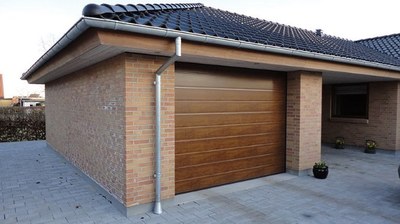
Storing your car in a warm garage during the winter eliminates many problems.
Clean glass, easy engine starting, easy maintenance and repair will extend the life of the car and preserve the health of the car owner.
In a warm garage with ventilation the car body will last much longer.
Those who like to fix their cars on long winter evenings know that metal and rubber become brittle in the cold, and repairs are often complicated by broken bolts or cracked plastic. Positive temperature in the garage allows you to work comfortably and without problems.
General heating of the garage
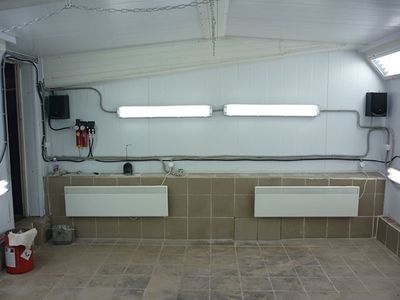
Conveniently heats the garage from a central boiler house or heating plantThe owner does not worry about fuel, and maintaining heat is done without his participation.
General heating is ideal for car repair shops, indoor parking lots, and garages for valuable cars.
Connect the garage to central the system is convenient, if it is located close to a house or heating main. The main advantage of this method is the ability to maintain a certain temperature in the garage throughout the heating season.
But there are also disadvantages:
- Risk of freezing of batteries during the off-season or during repair work.
- Large energy losses in the heating main.
- Relatively high cost.
- When connecting to the municipal system, you will need to obtain permission and install a heat meter.
Autonomous systems
More often than not, a garage has to be equipped with its own system, independent of external energy sources. As needed, autonomous heating It happens:
- Permanent. The garage is heated around the clock, in this case, in order to save money, the garage is insulated.
- Periodic. If you only need heat for an hour or two. Suitable for cold garages, installation costs are minimal.
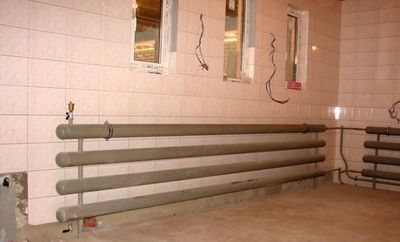
The advantage of an autonomous heating system is independence from external energy sources. Suitable if you don’t need a constant positive temperature in the garage.
Disadvantages of an autonomous system:
- Possibility of freezing of water in batteries.
- Costs for fuel, its search, processing, storage.
- Time and effort are spent burning fuel.
- Increased fire hazard.
Types
To heat a garage, a certain amount of energy is spent. It can be obtained by burning fuel - an energy carrier. Regardless of the type of fuel, the heating system can be:
- Local. Air heating occurs where the fuel is burned. It is often used to quickly warm up a garage during repair work.
- Central. Heat is captured and distributed evenly throughout the garage. There are systems with circulation of liquid coolant through pipes and radiators, and heating systems with air ducts. It is excellent for maintaining constant temperature. It is better to use non-freezing antifreeze based on ethylene glycol as a coolant rather than water.
- MixedTo save money, the central system maintains a positive temperature, and if there is a need to quickly heat the air, a wood-burning stove or a gas ceramic burner comes into play.
Natural gas as a fuel
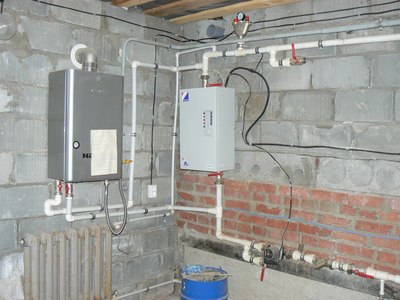
If it is possible to connect the main gas line to the garage, a convenient solution would be installation of a gas boiler and an open gravity heating system with batteries.
It is better to use antifreeze as a coolant based on ethylene glycol — even if the temperature drops below zero or the power goes out, the system will not be damaged.
The downside of such a system — high cost of equipment and installation, as well as difficulties in connecting to the gas main. The boiler must be located in an isolated room, forced ventilation is required.
If only liquefied gas in cylinders is available, it is better to organize local heating. A powerful gas heat gun can increase the air temperature in a standard garage in a few minutes. If you don't need such power, it's better to take a ceramic burner. It doesn't burn oxygen, it's safe and multifunctional. But a big minus is the high explosion hazard due to the possibility of dust and fuel vapors accumulating in the garage, burning out oxygen and dust in the room.
The option of heating with an open flame of an injector burner is not the best for a garage. An open flame quickly burns out oxygen, any fuel leaks may pose a fire hazard.
Attention! The use of blowtorches, gas burners and other heat sources with an open flame is not permitted during painting work, repair of the fuel system. Gas combustion equipment must be located in an isolated room with ventilation!
Heating with electric heating element
The use of electricity is distinguished by a wide variety of heating methods and techniques. Heating with electricity can be permanent and periodic. To organize it, you don’t need an isolated room.
Technical solutions for continuous heating with electricity.
- Closed gravity heating system with electric boiler, pipe system and radiators. Allows you to evenly distribute heat in the room, ideal for heating several boxes, multi-story garages. Minus - high cost of equipment and electricity, plus - safety and reliability of the system.
- Connection of convectors, heaters, ceramic panels. The advantage is safety and ease of connection, the ability to distribute heat throughout the entire room. The disadvantage is the need to lay electrical cables along the walls, so the fire hazard is higher.
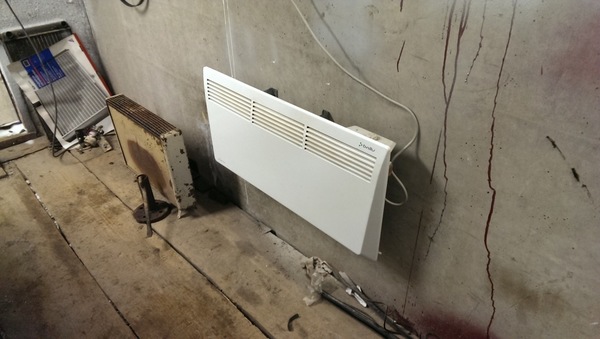
Photo 1. Electric convector installed in the garage. There should be a socket nearby to connect the device to the network.
- Heating with electric air gun or spiral heaters. Suitable for organizing periodic heating. Advantages - fast heating of the room, do not burn out the air. Disadvantage - increased fire hazard when fuel vapors, aerosols or dust accumulate.
- Using infrared films in the ceiling or walls of the garage. Advantage - uniform heat, does not take up space. Disadvantage - increased fire hazard, brittle insulation, possibility of damage to heating tracks.
Heating elements are:
- Airborne. The resistance of the thread is designed to maintain a certain temperature on the surface of the device.
- Water ones. Due to their high power, they burn out when turned on in the air and have factory sealed fastenings.
How to make a heater with your own hands
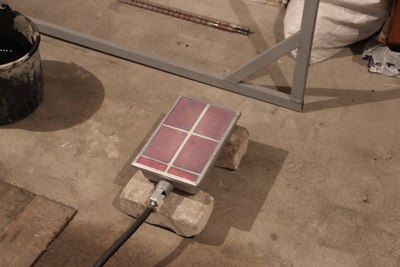
Heating elements are used for heating a garage from various industrial or household appliances. Among household heating elements, heating elements from electric kettles, water heaters and washing machines are popular.
They are connected to cast iron battery through a standard plug, taking into account the power and cross-section of the wire.
One section of a standard cast iron radiator gives off 0.1-0.3 kW/hour of heat, The number of sections is selected based on the power of the heating element. It is desirable that the heater be located along the entire length of the battery.
The battery is filling up 85% transmission oil or antifreeze, the plug is screwed on. The remaining 15% air serves as an expansion tank.
Attention! When carrying out electrical installation work remember about safety! All wires are placed in protective boxes, twists - only in the distribution box. Incorrectly selected wire cross-sections lead to fire.
On a homemade heater from a battery grounding must be connected, it is better to install a residual current circuit breaker at the entrance of electricity to the house.
Heating using a potbelly stove
Wood heating is used for periodic heating of the garage. The simplest metal potbelly stove it will warm up the air in half an hour, infrared radiation from hot walls will heat objects. This scheme has long been used by garage owners, valued for its simplicity and versatility. However, there are also disadvantages:
- Inconvenience in storing and preparing fuel.
- Uneven heating of the garage area. It will be hot near the stove, but cold in the far corner behind the car.
- Increased fire hazard due to hot walls and chimney.
Solve these shortcomings It is possible to equip the garage with a heating system.
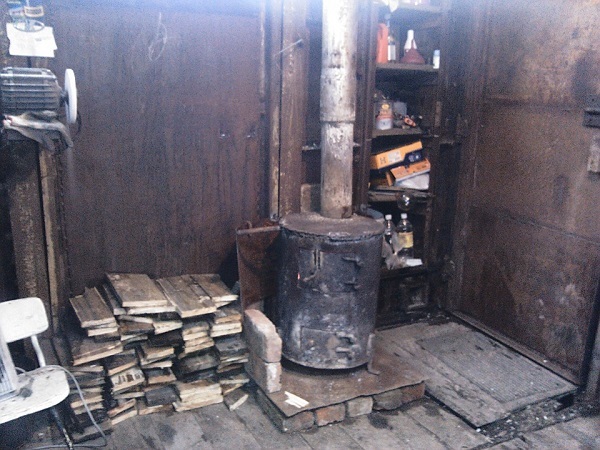
Photo 2. Potbelly stove for heating the garage. The device runs on wood, so it is necessary to organize space for storing it.
Heating system based on a furnace with a water circuit
The stove is installed outside the garage, in a separate room. Batteries are placed along the walls, and pipes are installed at an angle.
A potbelly stove is a simple metal stove. It consists of two chambers. — an ash pan with a grate and a firebox. The chimney pipe runs as far inside the room as possible to increase heat removal. Most often, a potbelly stove is made from a piece of an old large-diameter pipe or from a gas cylinder.
A heat exchanger is mounted on the stove. In practice, there are three options:
- Water jacket around the firebox. It is difficult to manufacture, but ideal in terms of heat removal. It is a "cold core", the wood does not burn completely, producing a lot of smoke and soot.
- Heat exchanger made of pipes inside the firebox. It is much easier to make using plumbing bends and pipes. The efficiency is lower, but the system works properly.
- Revolver type heat exchanger on the chimney. An excellent solution if you insulate the walls of the stove with non-flammable insulation. Firewood burns hot, the coolant in the "revolver" is quickly heated by the outgoing gases. High efficiency, but will require the installation of a circulation pump - the heating of the coolant is carried out as low as possible.
This heating system will quickly, evenly and safely fill your garage with warmth. It is important to monitor fire safety: the chimney passage through the roof must be thermally insulated, non-combustible material must be laid in front of the firebox, and a thermal insulation screen must be installed near the walls behind the stove.
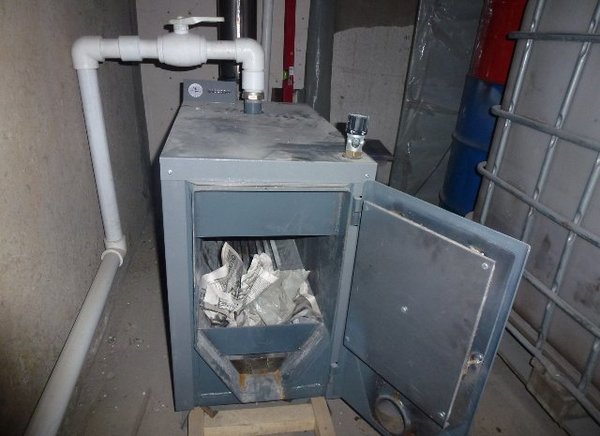
Photo 3. A potbelly stove installed in a garage. A water circuit is connected to it, which allows the room to be heated evenly.
Useful video
Watch a video that explains the principles of heating a garage using an electric boiler.
Which garage heating system to choose
There are a large number of options. To make a choice, we take into account the following parameters:
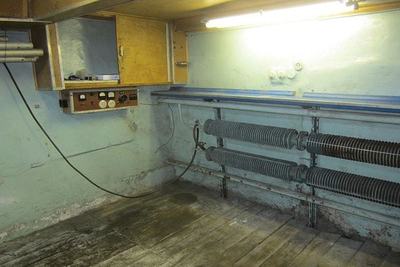
- Availability and cost of heat source.
- Cost of equipment.
- Heating mode.
- Compliance with safety regulations.
- Easy to install and use.
Based on the tasks and taking into account the features of the premises, choose the appropriate heating option. Busy people who need a warm car in the morning are better off installing gas or electric central heating.
Those who like rare garage repairs can get by with a gas or electric air gun or a potbelly stove. People who spend a lot of time in the garage can install a wood-fired heating system.
To reduce heating costs, Think about effective insulation and proper ventilation.



